
How To Grow Hot Peppers Indoors
Growing chillies might seem like a complicated task, but we're here to tell you that it really needn't be. Even if you don't have an adequate space outside to grow them, you can produce some high-quality peppers all from the comfort of home. Allow us to give you a breakdown of everything you need to know for a successful home growing project.
It's no secret that pepper plants, like all plants, need plenty of light and warmth to flourish. Those living in warm climates have both in abundance and can easily grow their plants outside with very little fuss. But what about those living in more moderate and cold conditions? Are their chances of cultivating peppers from home non-existent? Well, actually, no. It's entirely possible to provide your capsicum plants with everything they need, all from the safety of being indoors. Allow us to take you through everything you need to know about cultivating chillies indoors and how to make the most of it.
Why should you grow hot peppers indoors?
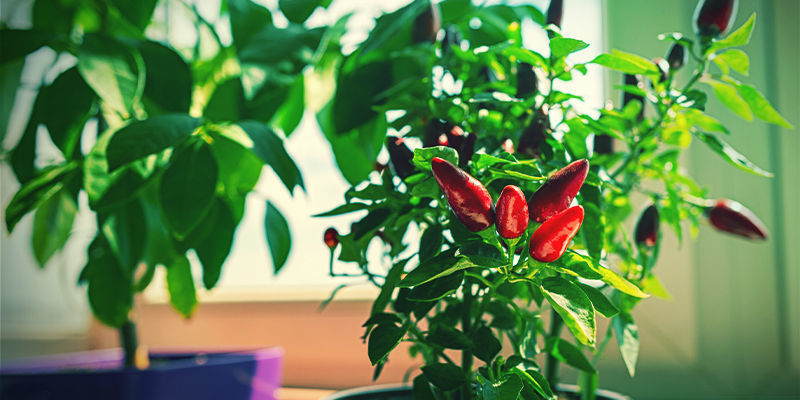
As mentioned, those not fortunate enough to live in consistently warm and sunny locations will seriously want to consider growing peppers and chillies indoors. Even if you live in a climate that can provide the occasional sunlight and warmth, growing outside can be demanding. But by growing indoors, you can regulate the temperature and light provided to your plants. Not only is it appropriate for those not living in the "right" conditions, but it's also a method ideal for people living in small apartment spaces or homes without access to a garden. You can have the perfect area to cultivate at home with just a few things. Because you're able to provide maintenance indoors at any time, it's arguably much easier to grow even the trickiest of pepper varieties with relative ease.
Which hot peppers are the best for growing indoors?
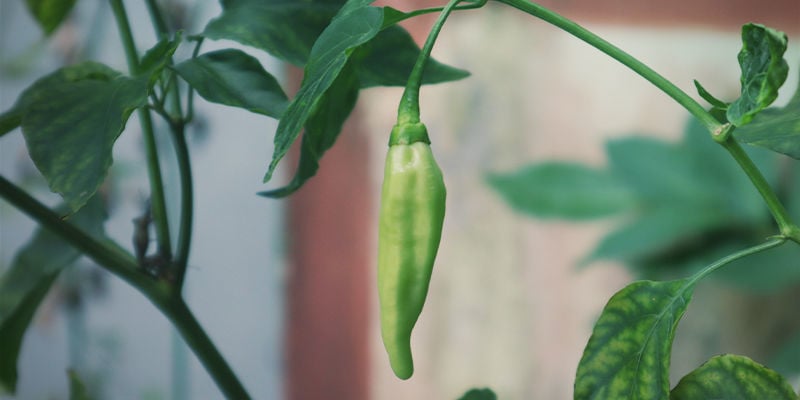
When it comes to picking out peppers to grow, which are the best for cultivating indoors? Well, the simple answer is: pretty much any of them. As mentioned, growing plants inside gives you unprecedented and constant access to provide maintenance and ensure they're growing correctly. So even the fussy varieties notorious for wanting a little more of a hands-on approach can be produced at home almost effortlessly.
However, if this is your first foray into the world of pepper cultivation, it might be best to stick to a variety that offers up a shorter cultivation period. This will allow you to gain significant experience while growing your plant. A jalapeno, for example, will require 85 days to mature from fruit set, but others will be ready to harvest much sooner. So when looking for seed, be sure to pick one that's within your skill set initially and then branch out into others as your confidence grows.
What do you need to grow hot chilli peppers indoors?
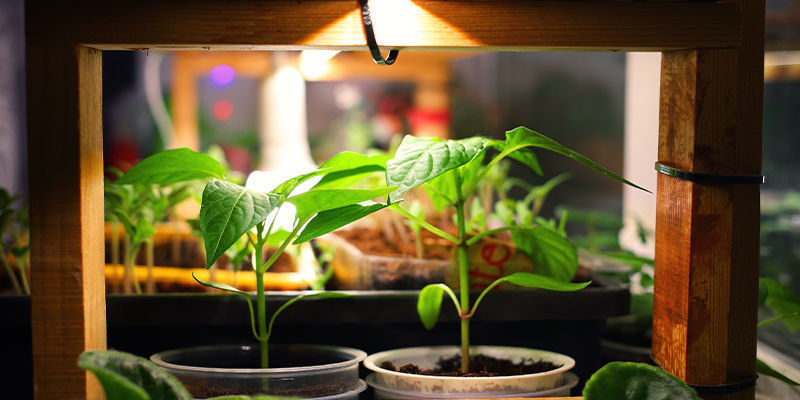
When it comes to growing chillies indoors, there are a few things you'll need for successful grow. But don't worry! We're not going to give you a massive shopping list, and fortunately, a lot of the equipment can be reused again and again, so as soon as you've finished your growing project, you can start your next one effortlessly. The following is a list of equipment you'll need for indoor growing:
Containers
As arguably the most obvious item on the list, containers are used to house your plant during its growing cycle. However, as the plant grows, its environment will need to change. So start with 10cm (4-inch) pots (if looking to germinate directly into the soil) and consider picking up some 20–25cm (8–10 inch) ones for when you need to transplant your chilli plant.
Substrate
This may require a little research as there are plenty of options when it comes to picking a soil or soilless substrate for your plants to flourish in. There are even specialised indoor chilli plant mixes you can pick up that will give your plants all of the nutrients they need to grow successfully.
Heat mat
As we're growing indoors, it's hugely important to regulate the temperature of your plants. This can easily be achieved through the use of a heat mat. A simple plug-in device, a heat mat can be dialled into a heat setting of your choice. It can provide your plants with a consistent and steady temperature that will allow them to flourish much in the same way they would outside.
Pruning scissors
Throughout the growth of your plants, you'll undoubtedly need to keep a strict level of upkeep and maintenance. One such way is trimming the twigs and leaves and ensuring your plant is getting all of the light it needs to flourish. Having a pair of pruning scissors nearby will be more than enough to do this.
Grow lights
While they can be expensive, a set of grow lights is invaluable to an indoor home growing project. While some plants grown indoors will be able to sit by the window for light, grow lights are perfect for providing a consistent and reliable source. The number you'll need will differ significantly, depending on how many plants you're looking to grow, but they are adaptable, not overbearing in size and can be placed in tight spaces. Perfect for those restricted for room.
Plant food
Sometimes your plants will need a little boost during their growing cycle, so it may be worth picking up some plant food to give them a hit of nutrients so they can perform better.
How to grow hot chilli peppers indoors
Now you've got all of your equipment ready for your indoor growing project, allow us to take you through the steps to everything you need to do to ensure your plant is performing the way you want it to. From germination to the eventual harvest, we've got you covered.
Germination
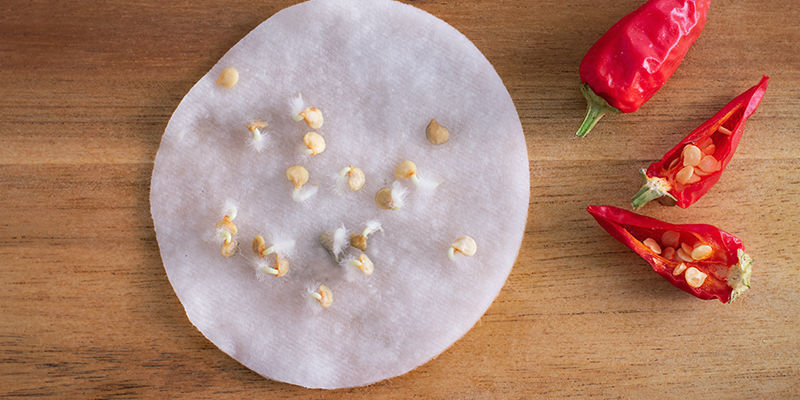
This stage of the growing process is a hugely important one. There are many ways to start the life cycle of your seeds, all with varying success rates. Some methods include placing some seeds in a damp paper towel and leaving it on a heat mat. By refreshing the paper towel with water and keeping it damp (not soaked), you should see your seeds begin to sprout within as little as 5–7 days—but it can take in excess of 3 weeks to see any kind of progress. So be patient!
For a more reliable way to germinate your seeds, you can always look to use a dedicated premade germination kit. One such product is the Plagron Seedbox. Germination kits are individual compartments filled with nutrient-rich soil that provide enough space for a seed in each. Simply push the seed gently beneath the soil, cover and add a little water. The germination kit can then sit on a heat mat at around 25–30°C until progress has been made. However, it's perfectly possible to germinate your seeds directly in soil if you're looking to use your own soil and plant pot for the job. The same rule applies, keep the soil moist but not soaked and provide heat until seedlings appear.
Soil mix
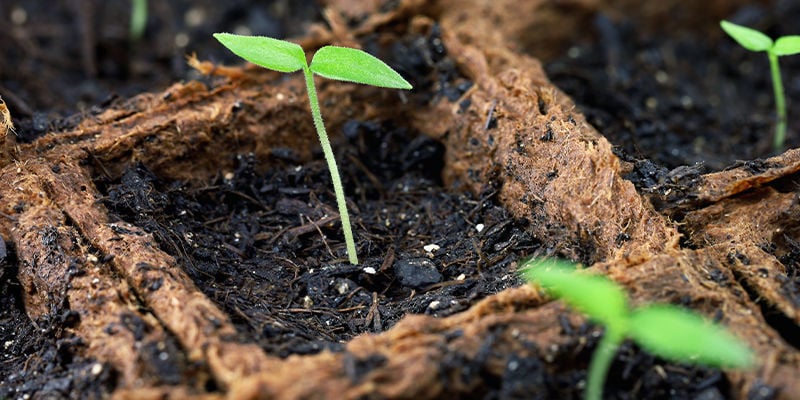
While the germination kit will have the perfect soil ready for your seeds, you'll need to think of the next step once your seeds have become seedlings. By filling your plant pot with the correct soil will ensure your plants will have the best possible conditions for the remainder of their growing cycle. When it comes to soil, capsicum plants do best in light substrate mixes that are combined with a little bark or a mulch, and/or some perlite. Be sure to test and ensure that the soil's pH level is anywhere between 5.9 and 6.5, and you set to go. Generously fill your containers, and they'll be ready for your transplanted seedlings in no time.
Transplanting
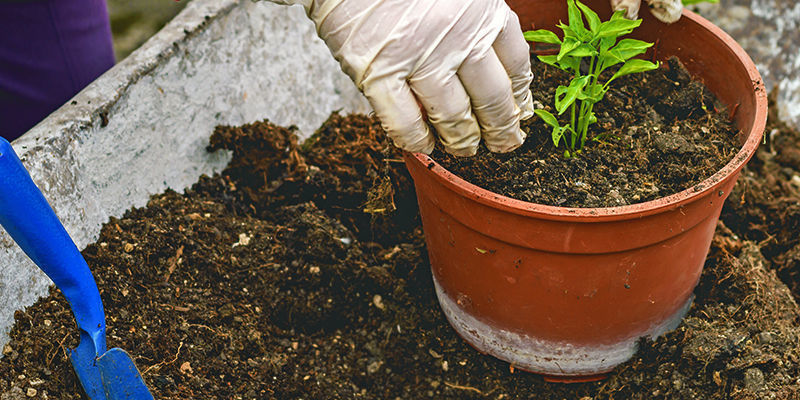
As your plants begin to flourish, it's time to transplant them before they get too big for their respective containers. Ideally, this should be done around 3–4 weeks after sprouting. Or, as a simple way to remember it, after the plant has produced its 3rd set of true leaves, it's time to repot it. As you can probably imagine, this is a delicate task and should be treated as such. To transplant, loosen the soil in the pot by gently squeezing the outside, before covering the soil with the palm of your hand. You want to place the stem between your index and middle finger, or middle and ring finger, and slowly turn the pot upside-down, safely letting the young plant slide out of its old home.
Water and nutrients
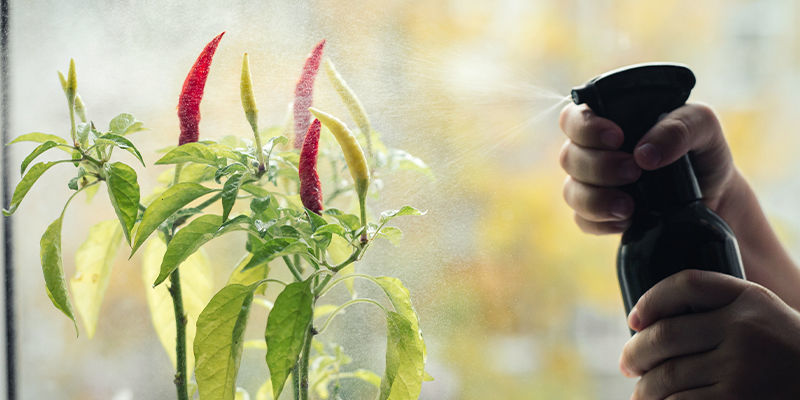
This is a crucial stage and can really be the deciding factor between a successful and unsuccessful growing project. As a result, it's hugely important to provide a regular watering schedule—but be careful not to overwater as this will undoubtedly be harmful to the plant. So take it easy and only water when your plants need it.
When it comes to nutrients, they can be an optional addition to your plants. You can certainly use tomato/pepper plant feed for your plants during their vegetative stage. However, much like water, be sure not to overdo it and follow the instructions to a tee. Overfeeding can cause problems.
Lighting

As a hugely important part of a plant's growing cycle, we need to provide our plants with enough light for them to flourish. Of course, during the summer months, plants can be placed on a windowsill to absorb all the light and warmth they can muster. However, during months that don't provide much of either, you can put your plants under an LED grow light for around 14–16 hours a day, and provide a consistent temperature by combining the light source with a heat mat. It goes without saying, but with the presence of more heat, be sure to keep an eye on your plants and soil to ensure neither fully dry out.
When setting up your lights, you can even use a small grow box to make sure that the light source is focused on the plants. This will also help to keep your entire growing project contained, so you don't need to worry about moving your containers or being in the way.
Harvest
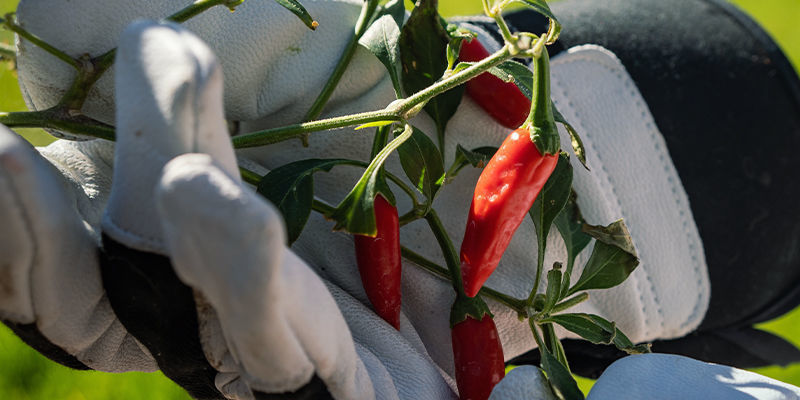
Obviously, this will vary from pepper to pepper, but there are certainly a few telltale signs to keep an eye out for when it comes to harvesting. Some chillies will change colour from a green to a deep red, others to a vibrant orange or yellow; this will give you a clear indication that they're ready to pick. Size can also be a factor, but more so in affecting heat, not maturity. Corking is also another way of knowing whether your berries are ready in some strains. Whitish lines appear on the pepper to show that it has reached maturity and is ready to be plucked.
But how do you remove your berries from the plant? Simply take the pepper in between your fingers near the stem and gently pull it against its growth direction to loosen it from the plant. Be careful, wear gloves and go easy when harvesting. Once harvested, you can say you've successfully cultivated plants indoors in the comfort of your home. Congratulations!
Tips for growing hot chillis indoors
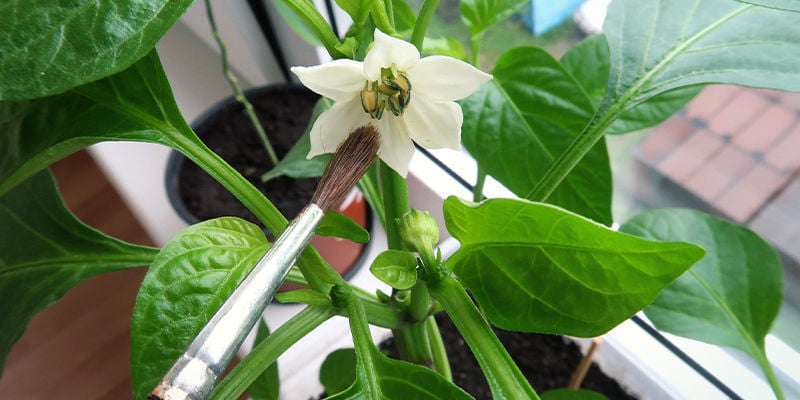
When it comes to growing chillis indoors, there are undoubtedly many tips out there to help you reach that haul of hot pods. With that in mind, we've picked out three that really showcase how to get the best out of your plants.
Pot size is important
This might seem obvious, but the importance of pot size should not be understated. You may feel like you're saving space by using a smaller pot, but placing your plants in a container that's too small will always do more harm than good. Without the proper room to stretch out, the plant's roots can become entangled, resulting in a "root bound" ailment. This will stop the plant from absorbing any water and nutrients, usually resulting in it dying. So be careful and always pick appropriately sized containers for your pepper plants.
Use stakes to support chilli plants
It's no secret that plants love to stretch out, given half the chance, so be sure to provide adequate support for them in the form of staking. While some plants won't necessarily need it and will stop growing, it's certainly worth erring on the side of caution and staking to make sure they maintain a vertical trajectory throughout their growing cycle. A healthy plant is undoubtedly a happy one.
Gently encourage pollination
Although capsicum plants are a self-pollinating species, you can look to hand pollinate them yourself by taking a small brush or cotton bud and swabbing the pollen from the flower. Once collected, you can gently rub it onto the flower stigma and let nature take its course. While this is a process that would happen naturally outdoors, thanks to wind and insects, indoor plants might need a little help.
Grow indoor hot pepper plants all year round
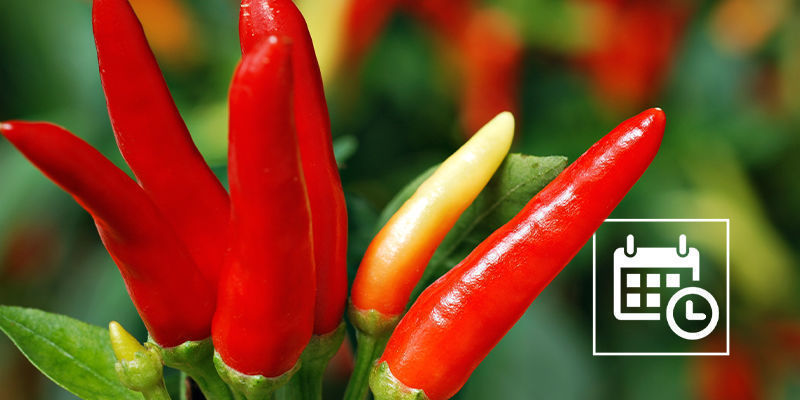
The beauty of growing pepper plants indoors is that they can be cultivated all year round. That's right! Regardless of the weather, come rain or shine, as long as you've got the conditions right in your growing setup, you can immediately begin another batch as soon as you've finished your first one. Dedicated outdoor growers will have to wait for the right season to roll around; you can get a headstart before anyone else.
So what are you waiting for? Get your indoor pepper growing project on the go; we can assure you, you won't regret it. In the meantime, for all your chilli and pepper needs, head over to the Zamnesia Peppershop, where you can have the pick of the finest seeds and pepper-related accessories around today.
-
 4 min
February 18, 2022
Tips For Growing Hotter Chili Pepper Plants
Surely it's down to chance just how hot your chili peppers can be, right? Well, while various factors determine spice level, there are actually several things you can do to really get the hottest...
4 min
February 18, 2022
Tips For Growing Hotter Chili Pepper Plants
Surely it's down to chance just how hot your chili peppers can be, right? Well, while various factors determine spice level, there are actually several things you can do to really get the hottest...
-
 6 min
January 28, 2022
The Most Common Chili Pepper Pests & Diseases
Cultivating chili pepper plants is not just about watering and feeding them; you must be prepared to tend to them when they're sick too! This guide will help you identify and treat the most common...
6 min
January 28, 2022
The Most Common Chili Pepper Pests & Diseases
Cultivating chili pepper plants is not just about watering and feeding them; you must be prepared to tend to them when they're sick too! This guide will help you identify and treat the most common...
-
 4 min
January 25, 2022
Best Companion Plants For Chili Peppers
If you love growing hot pepper plants, but want to do more with your outdoor grow, companion plants are an excellent way to diversify your garden and improve the quality of your pepper harvest....
4 min
January 25, 2022
Best Companion Plants For Chili Peppers
If you love growing hot pepper plants, but want to do more with your outdoor grow, companion plants are an excellent way to diversify your garden and improve the quality of your pepper harvest....
-
 5 min
January 24, 2022
When And How To Harvest Hot Peppers
You've taken the time to cultivate hot peppers, giving them everything they need to flourish throughout their growing cycle. Yet, arguably the most critical moment is fast approaching; when and how...
5 min
January 24, 2022
When And How To Harvest Hot Peppers
You've taken the time to cultivate hot peppers, giving them everything they need to flourish throughout their growing cycle. Yet, arguably the most critical moment is fast approaching; when and how...











 United States
United States








